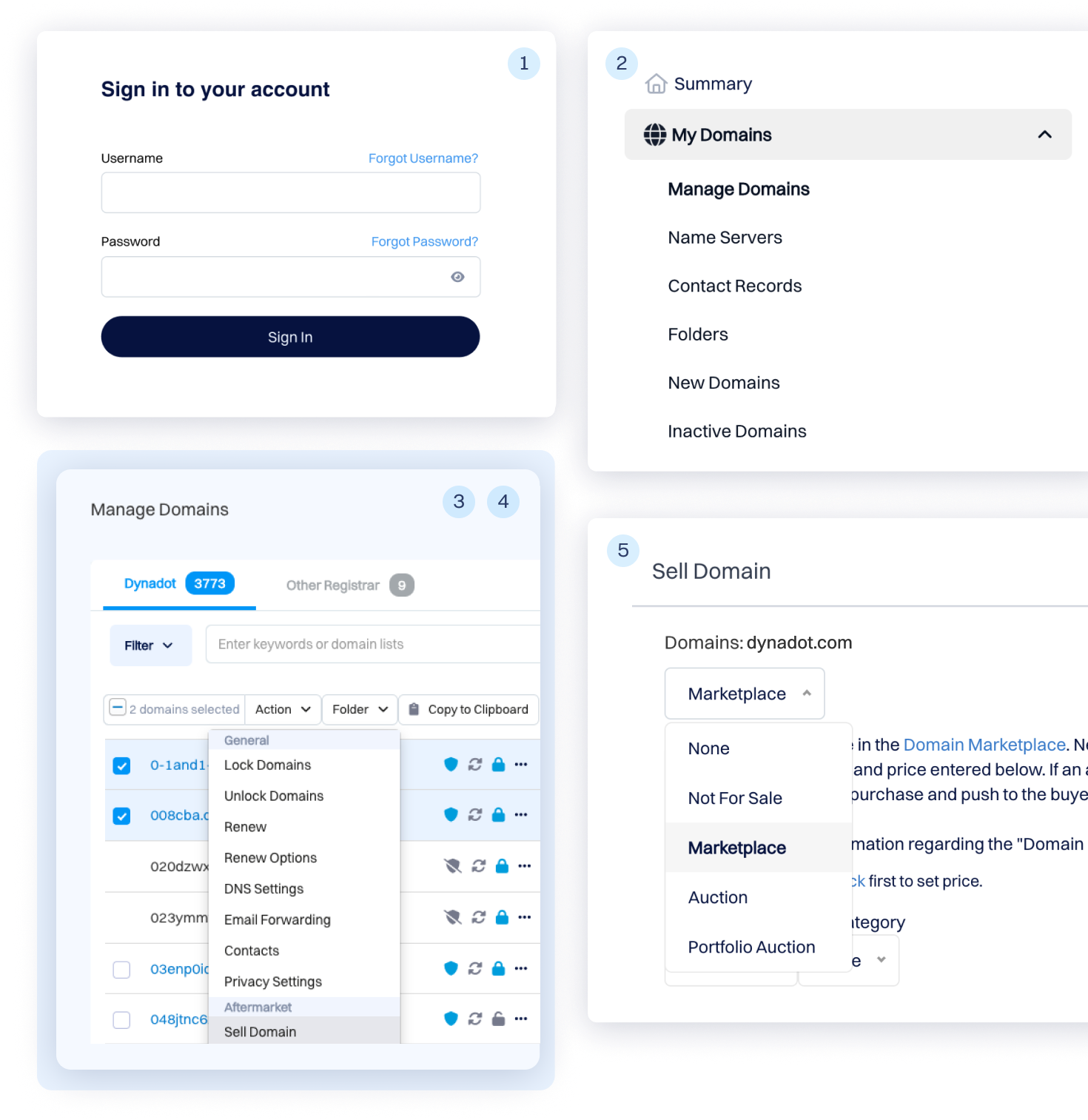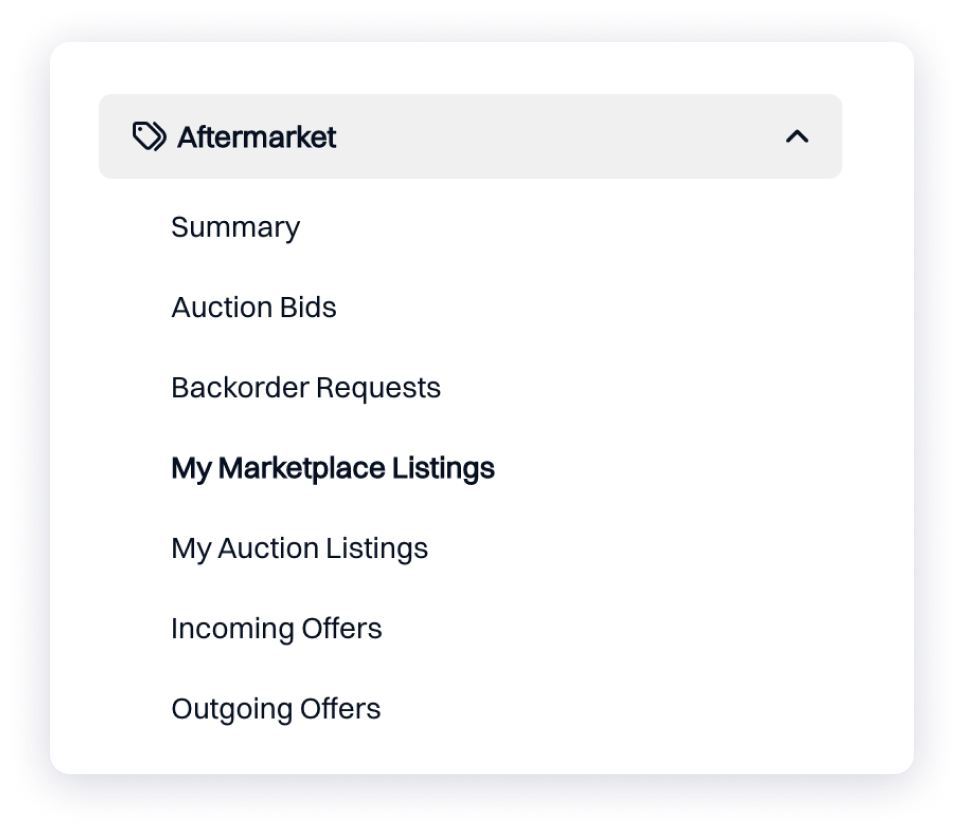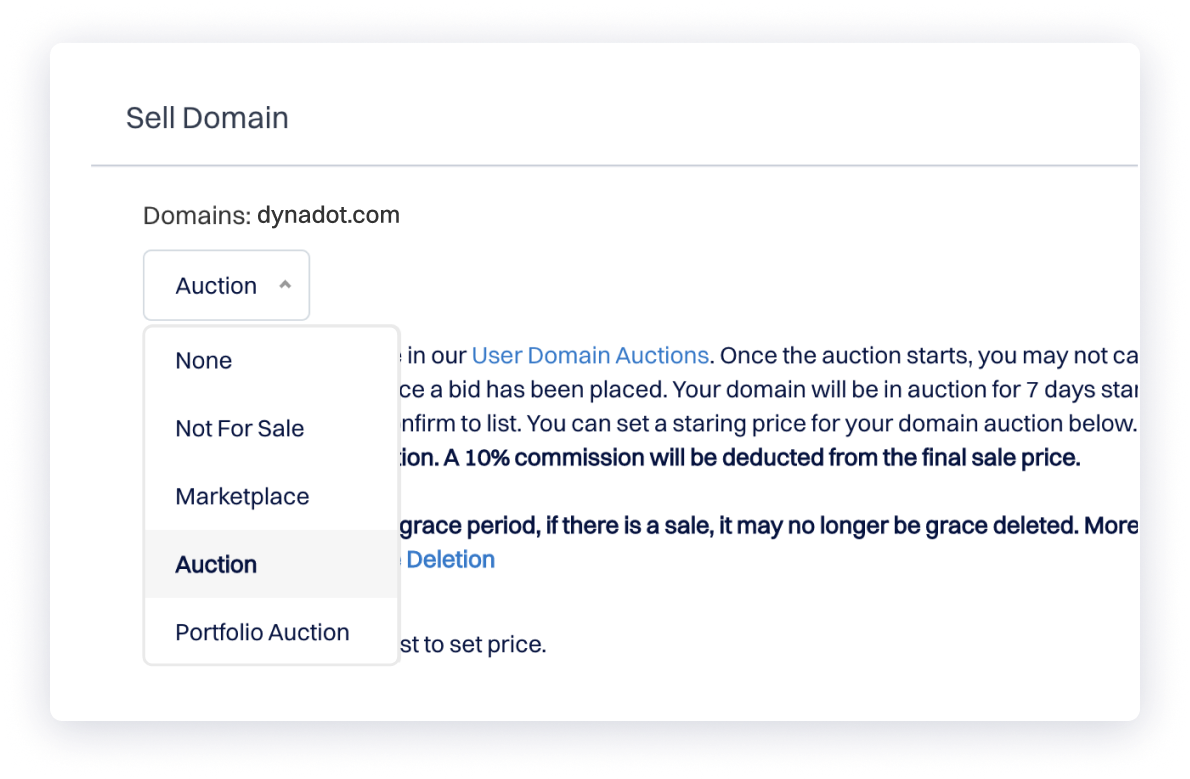DOMAIN INVESTING
01 . Introduction to Domain Investing
The process of transforming a simple domain into hundreds or thousands of dollars is exciting, right? While you'll likely agree, the path to fruition isn't so obvious. With Dynadot being a domain registrar focused on providing investing tools and services, we understand the challenges that come with jumping into the domain investing industry - it's intimidating. With this guide, we're here to bring you many steps closer to becoming knowledgeable on the subject, so you can start earning like the seasoned investors do.

What's in this guide?
In this domain investing guide, you'll gain an understanding of various domain investing strategies for monetization, what makes certain domains valuable to an investor, avenues investors take to acquire and sell domains, some general investing best practices, and tools/resources to help you along your merry way. We've divided up the guide into chapters. It's a long one - so take some notes, break it up as you see fit, and start making your way along the path of investing knowledge.

Investing your expectations
Domain investing is exciting, fun, intriguing, creative, and, best of all, another way to invest outside of stocks and real estate - who doesn't want that? On the other hand, it can also be challenging, research intensive, intimidating, and confusing at times. Why mention this? Because domain investing can be very rewarding yet requires commitment to see the fruits of labor. Managing your expectations while enjoying the journey of learning is crucial to seeing success. After that, you'll have a new source of revenue to look forward to!
02 . About Domains and Domain Investing
Before we even jump into domain investing, let's lay the foundation for what it's built upon - domain names.
What are domain names?
Domain names are a combination of characters, followed by a select top-level domain (TLD) such as .COM, .NET, or .XYZ, that point towards an IP address. When a user enters the domain name into their browser, they're sent over to that address, which contains data that ultimately generates the magical website for the end-user. Domains are like portals to content and information that can be used to represent brands and businesses online.
By registering a domain, you're investing into a one-of-a-kind digital property. There is only one of each domain name + TLD combination, which creates inherent value.
By registering a domain, you're investing into a one-of-a-kind digital property. There is only one of each domain name + TLD combination, which creates inherent value.
What is domain investing?
Domain investing is taking that knowledge that there can only be one unique domain registered and utilizing it to earn profit. Like all forms of investing, you put your money on the line with the goal of earning a return on your asset that is higher than your initial cost and upkeep.
A domain can generate profit in multiple ways, defined by the investing/monetization strategy the investor decides to use. This can include placing advertisements or affiliate programs links on a domain name's website, selling a domain to other investors, or even by selling them directly to businesses ('end-users') for them to use for branding or marketing purposes.
A domain can generate profit in multiple ways, defined by the investing/monetization strategy the investor decides to use. This can include placing advertisements or affiliate programs links on a domain name's website, selling a domain to other investors, or even by selling them directly to businesses ('end-users') for them to use for branding or marketing purposes.
Three stages of domain investing:
Research:
Acquiring knowledge, planning and selecting an investing strategy.
Acquisition:
Developing and growing a domain portfolio.
Applying Strategy:
Implementation of a domain investing strategy to earn revenue.
This is a distilled version of the investing process that may change from one investor to another.
Are there opportunities to invest?
This is a common question by those intrigued by the domain investing world but hesitant to jump in. After all, businesses and investors have been in the space for over 30 years now, and it can seem difficult to break into an area that may seem so saturated and defined.
The good news is, there are always great opportunities to start investing. If anything, there are more avenues available today to acquire great domains if you're willing to put in the time. The methods of domain acquisition for investors have changed - gone are the days of searching and registering an extremely obvious high value domain. In exchange, nowadays aftermarkets continually pull in great opportunities for investors to tap into.
It's important to consider that businesses are still being established and they'll always need a digital home in today's virtual world. Commerce and online representations of brands is a necessity, which creates near endless opportunities for investors to acquire domains that hold potential value for both new and existing brands. This means that revenue from investing in the right domains is always just around the corner. With newer top-level domains creating broader, unknown-levels of opportunities as well, the future of domain investing is bright.
The chances to invest and make profit are plentiful, you just need to be smart about your investments. Let's start by discussing how domain investors actually make money.
The good news is, there are always great opportunities to start investing. If anything, there are more avenues available today to acquire great domains if you're willing to put in the time. The methods of domain acquisition for investors have changed - gone are the days of searching and registering an extremely obvious high value domain. In exchange, nowadays aftermarkets continually pull in great opportunities for investors to tap into.
It's important to consider that businesses are still being established and they'll always need a digital home in today's virtual world. Commerce and online representations of brands is a necessity, which creates near endless opportunities for investors to acquire domains that hold potential value for both new and existing brands. This means that revenue from investing in the right domains is always just around the corner. With newer top-level domains creating broader, unknown-levels of opportunities as well, the future of domain investing is bright.
The chances to invest and make profit are plentiful, you just need to be smart about your investments. Let's start by discussing how domain investors actually make money.
MAKING MONEY
03. Domain Investing Strategies
There are multiple approaches to make money through domain investing, and we'll be outlining three common tactics used by many domain investors.Domain Flipping - Buy Low, Sell High Strategy
Creating Value - Content Commitment Strategy
Domain Parking - Continuous Revenue Strategy
Pros:
- A keen eye for spotting domain opportunities can make this strategy consistently profitable
- Possible to maintain momentum of interest in certain domains after they're acquired, helping with quicker sales
- Industry and vertical knowledge can be used to spot opportunities that may not be apparent to other investors
Cons:
- Requires strong foundation of domain evaluation knowledge
- Requires frequent monitoring of various aftermarkets to spot opportunities
- Can be time sensitive if you want to maintain public interest in the domain
- Has inherent risk if domain's value is misjudged
- Generally a time-consuming strategy
Details:Domain flipping is one of the more common tactics due to its relatively simple process of acquiring an undervalued domain, followed by selling it to make a profit. This strategy is often a short-term play to make marginal gains on the initial acquisition expense.
To successfully partake in this strategy, you'll need a solid understanding of domain costs and values. Because of this, this strategy is actually one of the more difficult investment tactics to dive into as a newer investor, despite it being attractive due to its straightforward nature.
Domain values can fluctuate based on many factors, including emerging trends both in the domain industry and in the industry where the domain name itself fits into. This is on top of the various other criteria that make a domain valuable (which we cover in chapter four). Flipping domains requires a hefty time investment to pinpoint domains that should be purchased at a low to reasonable price in order to resell. A vast majority of the time these valuable domains are bought through aftermarket platforms via expired auctions or placing backorders, which we cover in more detail later.
It is important to note that time doesn't always increase the value of a domain, demand does. While patience is required to sell a domain, simply parking a domain to try to sell it years later will likely not improve its value. That is why buying low, selling high is often combined with other domain investing strategies.
To successfully partake in this strategy, you'll need a solid understanding of domain costs and values. Because of this, this strategy is actually one of the more difficult investment tactics to dive into as a newer investor, despite it being attractive due to its straightforward nature.
Domain values can fluctuate based on many factors, including emerging trends both in the domain industry and in the industry where the domain name itself fits into. This is on top of the various other criteria that make a domain valuable (which we cover in chapter four). Flipping domains requires a hefty time investment to pinpoint domains that should be purchased at a low to reasonable price in order to resell. A vast majority of the time these valuable domains are bought through aftermarket platforms via expired auctions or placing backorders, which we cover in more detail later.
It is important to note that time doesn't always increase the value of a domain, demand does. While patience is required to sell a domain, simply parking a domain to try to sell it years later will likely not improve its value. That is why buying low, selling high is often combined with other domain investing strategies.
TIP
Become familiar with domain evaluations through domain sale history resources and test your knowledge by attempting to guess final sale prices. Your accuracy at gauging prices will assist with spotting potentially undervalued domains to resell at a higher price.
With the three more common domain investing strategies out of the way, let's dive into the domain names themselves. Being aware of the strategies is only one component of investing, you're going to need some good domains in your portfolio too. But how do you know which domains to pursue?
CRITERIA FOR DOMAINS
It's important to know that pricing a domain is a feat in itself, with experience and knowledge ultimately being king to help place an accurate price onto a domain. There are some signals that can help determine whether a domain is valuable. We've compiled a list below that may provide an indication of strong domains to invest in. Even with these signals in mind, it's very important to try and find similar recent domain sales to at least provide a reference point when it comes to where a domain price is situated.
04. What Makes a Domain Valuable
One of the most crucial components in domain investing is also one of the most obvious - finding the right domain names to acquire. In one's journey investigating domains, they'll come across domains with outlandish evaluations - both on the overvalued and undervalued spectrum. Since pricing a domain has many factors, it can be challenging to land on a baseline, even for seasoned investors.It's important to know that pricing a domain is a feat in itself, with experience and knowledge ultimately being king to help place an accurate price onto a domain. There are some signals that can help determine whether a domain is valuable. We've compiled a list below that may provide an indication of strong domains to invest in. Even with these signals in mind, it's very important to try and find similar recent domain sales to at least provide a reference point when it comes to where a domain price is situated.

05. Buying Domains
Acquiring domains can be both exciting and daunting, as it's where investors put their money on the line hoping for that sweet positive return down the road. The best part of buying domains is that there are always great investing opportunities available, with many avenues to discover and add domains to your portfolio.Before You Buy
Acquiring a domain can occasionally be very exciting, especially if the domain seems obviously undervalued on a marketplaces. Before you check out that domain in your cart or place the bid on the domain you've been eyeing, there are a few things you should keep in mind.
Domain Acquisition Methods
As the domain name space has evolved, so have your options for acquiring domains. Below are various avenues you can take to building out your domain portfolio.Tips for Buying Domains

06. Selling Domains
While domain acquisition can be fairly straightforward once you find the domain you want to register, selling domains can be a more challenging and prolonged affair. Luckily, there are various ways to approach the selling process that can all bring you closer to landing sales.Before You Sell
It's easy to find a domain you want to sell, quickly place it up on an aftermarket, and hope for the best. While this may be just enough to get the job done and land a few sales, it may be helpful to consider the following - especially with more valuable domain names.
Domain Selling Methods
There are multiple routes you can take to sell your domain names, which should be mixed and matched to help bring awareness to your domains for sale.Tips for Selling Domains

07. Building and Managing Your Domain Portfolio
Starting Your Domain Portfolio
Acquiring your first domain for your investing portfolio can be intimidating, as it will be your money on the line making the acquisition happen. While daunting, it can also be exciting to think about the prospect of earning. Here are some general tips to help guide you when building your portfolio piece by piece.Portfolio Organization
Make it your priority to go slowly and stay organized when starting your investing journey. To accomplish this, there are online tools that can help monitor and meticulously organize all your domains. You can also rely on a simple yet robust spreadsheet, whether through excel or a free platform like Google Sheets. This will provide control over tracking your domain portfolio information, such as:
This organization goes beyond just managing your domains. When you're new to domain investing, you will come across useful web pages, articles or forum posts that will offer valuable insight that can change how you approach investing. Maintaining a library of useful articles in an organized directory will keep you efficient and informed, especially when there is limited time to commit to investing and research.
Lastly, find a registrar that allows for easy domain management in their platform. Dynadot allows you to set up folders to store and label your domains easily while providing intricate filtering options to sort through your domains based on criteria. You even have the ability to add domains residing under other registrars to help you keep track of your entire domain portfolio from one control panel.
- Domain status (acquisition dates, expiration dates, negotiation status)
- Domain pricing (estimated price, acquisition price, reference domain prices)
- Outreach status (any current bids or contacts regarding selling)
- Which registrar the domain in under
- Which industry/category/interest the domain can be placed under
- The domain's TLD
- Research required or any other notes you want to make
This organization goes beyond just managing your domains. When you're new to domain investing, you will come across useful web pages, articles or forum posts that will offer valuable insight that can change how you approach investing. Maintaining a library of useful articles in an organized directory will keep you efficient and informed, especially when there is limited time to commit to investing and research.
Lastly, find a registrar that allows for easy domain management in their platform. Dynadot allows you to set up folders to store and label your domains easily while providing intricate filtering options to sort through your domains based on criteria. You even have the ability to add domains residing under other registrars to help you keep track of your entire domain portfolio from one control panel.

Where to Keep Your Domain Portfolio
When starting your investing journey, your domain portfolio has to start somewhere. You should be looking for a portfolio home that provides the tools to manage small or large domain portfolios that also allows for a variety of acquisition methods directly through their platform. Every domain investor will have their preferences, and we encourage everyone to try and discover a platform that best fits their needs. Many larger investors actually use multiple homes for their portfolio, which has its own advantages and disadvantages.At Dynadot, our platform is built to support domain investors on their journey and to provide all the tools they need to manage their portfolio while acquiring domains at a reasonable, low price.
Aftermarket Listings
From expired domain auctions and backorder placements to user auctions and buy-it-now user market listings, we have a wide variety of acquisition resources for you to tap into.Learn MoreFree Website Builder
Looking to create content for your new domain names? Our powerful website builder provides all the tools you need to get your websites running quickly.Learn MoreSaving Options
We constantly push our domain registration, transfer, and renewal prices to be some of the lowest in the industry. You can also save even more with our bulk and super bulk prices!Learn MoreDomain Management
All the tools are in place for you to set-up and manage your portfolio - all with an easy-to-use interface. From bulk domain adjustments to folder management, we help you stay organized.Learn MoreFor-Sale Landing Page
Easily set your domain names to our stylish for-sale landing page. We make it simple for buyer prospects to contact you, so you can sell your domains quickly. You can even negotiate with our make-offer system.Learn MoreA Powerful API
Our API has all the basic and advanced functionality you need to acquire and manage your entire portfolio. If you're looking for depth and efficiency, our API can help.Learn More08. Must Knows for Domain Investing
There aren't many barriers for getting started with domain investing. Once you have your aftermarket and/or registrar selected, along with a payment method, you can start registering domains at a whim. However, there are some key facts that are important to know to smooth out the learning curve.
Time and Money
Like every form of investing, outcome is going to be tied to both your budget allocation and your time investment. Both time and money will be a limited resource when you're starting to invest, and deciding how much of each should be seriously considered.Time allocation
For time allotment, research should and likely will take priority when learning the ropes. This can include reading step-by-step guides on using tools, watching videos on domain-related topics, or participating in online community discussions. When you're ready, shift into researching actual domain names, reviewing aftermarket listings and monitoring auctions of interest. All research will require your time, so consider how much you'll put aside daily or weekly and integrate it into your schedule. The more diligent you are about building your foundation of knowledge, the higher the likelihood you will start your investing journey off strong. You'll be better equipped to make confident and informed decisions.
Even seasoned investors require time investment to see success. Ensure you accommodate for this, and have some available time to either manage your portfolio or help it grow.
Even seasoned investors require time investment to see success. Ensure you accommodate for this, and have some available time to either manage your portfolio or help it grow.
Budget allocation
When starting to invest, consider a limited budget that's designed around your investing strategy and even consider the number of domains you'd ideally like to obtain within that budget. This budget should be your baseline to help determine how you want to approach acquisition.
Example: You may choose to take the content building strategy approach on brandable domains while setting a $1,000 budget limit to find two or three domains to obtain through an aftermarket. Alternatively, you could spend your time researching keyword ideas in niche industries and hand register 10 domains for less than $100 to resell to businesses in those industries. It all depends on your investing strategy.
You'll need to decide the approach, research accordingly, and establish the limited budget. Just ensure the budget in mind is appropriate and doesn't cause you financial strain. All forms of investing can be risky - don't overcommit. Focus on gaining experience first and foremost.
Example: You may choose to take the content building strategy approach on brandable domains while setting a $1,000 budget limit to find two or three domains to obtain through an aftermarket. Alternatively, you could spend your time researching keyword ideas in niche industries and hand register 10 domains for less than $100 to resell to businesses in those industries. It all depends on your investing strategy.
You'll need to decide the approach, research accordingly, and establish the limited budget. Just ensure the budget in mind is appropriate and doesn't cause you financial strain. All forms of investing can be risky - don't overcommit. Focus on gaining experience first and foremost.
Renewal Fees
Regardless of whether you own 10 or 100 domains, renewal fees are an expense that needs to be considered when it comes to maintaining your domain investing portfolio and deciding on how many domains you want to acquire. Creating a wide domain portfolio through hand registering could impact your allocated budget (as hand registering can take time to profit from). On the other side, slowly building up your portfolio to ensure that every domain has value will lower your annual renewal costs. Just be aware that TLDs have varying renewal costs. You can see the renewal rates for Dynadot on our TLD prices page.
TIPTry not to get fixated on making a profit on all domains in your portfolio. If a domain you hand registered when you started investing is not going to provide long-term value, it can be wise to let it expire rather than paying repeat renewal fees.

Transferring Domains
Understanding domain transfers is crucial as a domain investor - after all, if you can't transfer in or transfer out a domain, you won't be building your portfolio with aftermarket domains or making any money through selling.
Here is an overview of what is required to transfer a domain, whether you're receiving or sending out a domain to another registrar/users account:
Be sure to familiarize yourself with popular registrar domain transfer protocols. The information above is only an overview. Many registrars have unique procedures when it comes to transferring. As a best practice, it is recommended that the transfer is done in conjunction with an escrow or domain broker service to secure the exchange if the domain was purchased through an aftermarket platform such as Sedo or Afternic.
For more information about the domain transferring process through Dynadot, see the domain transfers section of our help pages.
Here is an overview of what is required to transfer a domain, whether you're receiving or sending out a domain to another registrar/users account:
- The domain to be transferred must be registered or in your account for more than 60 days.
- The domain will need to be unlocked to successfully transfer, which is a security measure to prevent unauthorized transfers.
- With your domain unlocked, you can access the domain's authorization code. This name may change based on the registrar, it is also often called an EPP code. This code is shared with the buyer OR inserted into a registrar to initiate the start of the transfer process if you are the buyer.
- The transfer process can take anywhere from a few hours to ten business days. If the transfer was made to another registrar, another year will be added to that domain name's registration.
Be sure to familiarize yourself with popular registrar domain transfer protocols. The information above is only an overview. Many registrars have unique procedures when it comes to transferring. As a best practice, it is recommended that the transfer is done in conjunction with an escrow or domain broker service to secure the exchange if the domain was purchased through an aftermarket platform such as Sedo or Afternic.
For more information about the domain transferring process through Dynadot, see the domain transfers section of our help pages.
Negotiation
When it comes to buying and selling domains directly to or from other users, negotiation becomes a focal point. This is a key area you'll want to be conscious of as it becomes much more prevalent once you're selling high value domains to both end-users and other investors.Since each investor or end-user places value in different domain criteria, it is important to establish your minimum you would be willing to receive (if you're selling) or the maximum you'd be willing to pay (if you're buying) prior to entering negotiations to guide sound decisions. Take time and do your research before committing, as rash decisions can lead to bad investments. If you're new to negotiating, it is worth spending time learning about various negotiation approaches that compliment your personality by reading, taking courses or even through discussing with other investors.


Staying Informed
Keeping up to date with the domain investing community offers a wide range of benefits that you will eventually see trickle into your investing efforts. Joining in on investing forums, reading blogs and news sites that will keep you informed on industry news, attending industry events such as NamesCon, and reviewing sites that compile domains for sale/highlight specific sales from the week or month should all be considered. These are fantastic ways to understand trends and broaden your perspective when it comes to investing approaches from other investors that frequently participate in buying domains for sale and selling domains.Many of the members contributing to these content sources have been involved in domain investing for years and comprise a wealth of knowledge. If you can tap into them for insight, you will make better evaluations when it comes to important investing decision points and placing your domains for sale.
New vs Classic TLDs
There are different investing styles and preferences that go beyond strategies for monetization, and one area that's garnered a lot of discussion in the domain investing scene is new versus classic top-level domains.
TIPWhile we go into brief descriptions below on both new and classic TLDs, it's important to conduct your own research to determine which top-level domains fit your investing needs and objectives.

Classic TLDs
It's undeniable that some of the original, older top-level domains (such as .COM, .NET, and .ORG) have some inherent value attached to them due to a variety of factors, including their familiarity, history, flexibility, popularity, and general reputation. Businesses around the globe aim for domain extensions that their audience expects, which most commonly falls under this classic TLDs category. With the higher demand, value is created. Some of the most valuable domains will fall under classic TLDs, which ultimately makes them popular targets for investors. Despite their popularity, there are two common issues with some of the classic domain extensions: accessibility and affordability.
With the long history of the classic TLDs (relative to the internet), it can be difficult to acquire valuable domains under them due to their popularity - with brands and investors alike registering and holding many of the popular options. Due to this, it's also had an effect on aftermarkets where domains under these TLDs are typically more expensive to acquire. There are always opportunities to invest in classic TLDs to yield some great results - it just may require additional research, creativity and/or cost to incorporate into your portfolio.
With the long history of the classic TLDs (relative to the internet), it can be difficult to acquire valuable domains under them due to their popularity - with brands and investors alike registering and holding many of the popular options. Due to this, it's also had an effect on aftermarkets where domains under these TLDs are typically more expensive to acquire. There are always opportunities to invest in classic TLDs to yield some great results - it just may require additional research, creativity and/or cost to incorporate into your portfolio.

New TLDs
As of the mid 2010's, hundreds of new TLDs (both generic and country-code top level domains) hit the domain market for public registration. These domain extensions offer businesses, brands, and investors the opportunity to narrow their targeting to specific industries, audiences, or interests. With almost 2000 top-level domain options available, it's easy to see how investors are wary of their potential - especially as some are sure to gain more traction than others.
These new TLDs do offer some exciting opportunities with the tradeoff certain TLDs may never fully catch on for businesses and individuals:
These new TLDs do offer some exciting opportunities with the tradeoff certain TLDs may never fully catch on for businesses and individuals:
- Availability: Since each of these TLDs are newer, the likelihood of finding an available strong base domain increases, which means if the TLD's popularity does eventually boom, you'd have a good chance of making profit.
- Affordability: While this isn't always the case, many new TLDs have a lower registration price, making the cost of entry more accessible to investors. Getting ten domains at the cost of one can be beneficial.
- Narrowed Targeting: Since these domains typically focus on an industry, interest, or audience, investors can use this to their advantage by tailoring their portfolio to their existing interests or knowledge, which could lead to potential value down the road.
09. Recommended Domain Investing Tools
Choosing the right tools is one of the easiest ways to put yourself on the path to success when domain investing. There is an incredible amount of options available on top of the recommendations we list below. We encourage you to conduct research to find a mix of resources that align with your time, monetary and investment strategies.
Escrow
As soon as you move towards buying or selling domains, find yourself an escrow service to securely go through the buying or selling process. An escrow involves bringing in a third party who receives and distributes money on your behalf based on an agreement (in this case, sending or receiving money in exchange for transferring in or out a domain). There are many issues that can arise when doing direct exchanges with a buyer or seller, with the largest being scams. Take the extra step and avoid potential challenges by using an escrow service.Aftermarkets Tools
Aftermarkets are often called domain marketplaces. Aftermarkets are the bread-and-butter platforms for a vast majority participating in domain investing. They provide an outlet to easily get your valuable domains in front of the eyes of potential buyers. They will also be the tool you use to acquire some of your most valuable domains. Every aftermarket has its own unique user base, set of built-in tools, interfaces, customer support and commission fees, which is why we emphasize finding a few domain aftermarkets that you gravitate towards and monitor.Types of Evaluation/Research Tools
Discovering the value of a domain you own or one you have your eye on acquiring can be difficult without the right tools, even as an experienced domain investor. Domain evaluation resources can assist in evaluating the domain's price. There are various types of tools that will assist with your investing journey that should be considered staples in your repertoire:With all these tools, remember that evaluating a domain is going to be subjective. Always try to use multiple resources to be as informed as possible, regardless of whether it is a domain you are selling or a domain you want to purchase. You can use these evaluations or research tool insights as part of your criteria for negotiating price ranges for end-users making purchases or other investors looking to buy.
10. Domain Investing Pitfalls
Domain investors unfortunately occasionally tread into gray areas that aren't recommended to venture into when it comes to which domains to acquire. There are also certain domain extensions that have requirements that need to be met. It's important to be aware of the following when jumping into domain investing as they can cause frustration, legal issues and/or money lost.
Domain Squatting
Known as "cybersquatting", domain squatting occurs when a user registers a domain name that has a branded/trademarked keyword, name or slogan from a company or individual. Registrants who participate in this are usually either trying to block the domain from being registered by the company/individual or are using it as a part of their portfolio to profit by applying various investment strategies.ICANN has the Uniform Domain-Name Dispute-Resolution Policy (UDRP) in place to prevent users from abusing this tactic. Avoid registering branded or trademarked terms all together.
TLD Regulations
Although a majority of TLDs can be registered without specific or unique rules attached to them, there are some (particularly country-code TLDs and some generic TLDs) that have restrictions. These restrictions are created by the TLDs registry and they decide on the requirements for those restrictions. Many of the restrictions involve living in a certain place or locational restrictions on gaining access (for example, you need to be a Canada resident to register .ca domains). You can see a list of all the restrictions by going to our TLD listings page and reviewing the "restrictions" column.Scammers and Fraud Transactions
When it comes to dealing with other buyers and sellers, it pays to be cautious. There are numerous shady tactics others can use when it comes to domain investing. Examples include lying about a domain's information, owning stolen domains and scams regarding transactions. This is why it is important to conduct research prior to committing to purchasing a domain - know the domain's history and verify the ownership via Whois Lookup. When you're ready to make a purchase, use an escrow service or a domain broker to help keep the transaction safe and the exchange smooth.11. Selling Domains with Dynadot
If you're looking for a domain registrar to start your domain investing journey, we encourage you to check out our tools and services as well as section 6 where we explain the process of selling domains.
Your Dynadot Selling Options
Dynadot offers two ways to list your domain for sale: our marketplace and user auctions. These options allow buyers to purchase a domain at a listed price, make an offer, or place bids on your domains depending on how you create your sales listing.
User Market
Dynadot's User Market allows you to list your domain names for sale or find the listed domains to purchase. Selling domains on our market helps you put it in front of thousands of potential buyers that frequently visit the listing.Our User Market offers two sale listing types:
Make Offer
Allow potential buyers to send you their offers. If you're not satisfied with the initial offer, you can request a counter-offer and continue the negotiations until reaching an agreement. When you agree on a price, you'll have to finalize the sale by unlocking your account and selecting the currency for the order. The link will be sent to the buyer, and you will get an email once the buyer submits the order.

Buy It Now
Set an exact sales price when listing the domain name for sale. This allows the buyer to add the domain to their cart and purchase it directly.
Process of listing your domain name in Dynadot's User Market:
1. Sign in to your Dynadot account.2. Select "My Domains" from the left-side menu bar and click "Manage Domains" in the drop-down.
3. Check the box next to the domain name(s) you wish to list for sale.
4. Select "Sell Domain" from the "Action" drop-down menu.
5. Change the dropdown menu from 'None' to 'Marketplace', and then add a category, subcategory or a description for your domain. Then, click on 'Save settings'.


The default setting is 'make offer' for the listing. You can change this to set a price by editing your listing under the 'My Marketplace' menu in the 'Aftermarket' section in your control panel.
User Auction
Auctions are a perfect way to avoid negotiations with the potential buyers, or having to research the prices and set one yourself. All you have to do is list your domain name under 'User Auction', set the minimum bid amount and then wait to sell to the highest bidder.The process of listing is the same as with selling on the Marketplace, up until the final step.
- Click on 'Sell on Dynadot' in the 'Bulk Action' drop-down menu.
- Choose 'Auction' instead of 'Not For Sale'.
- Set a price and save settings.
Once you save the changes, you can't modify the listing. But, you can cancel the bidding any time before the first bid is placed.

Expand Your Selling Reach
Tools

12. Further Research & Getting Informed
Domain investing revolves around continued learning to have consistent success. Even experts who have been investing for over 15 years are still learning from experiences and from the ever-evolving marketplace. Industries change, and interests of end-users will continue to shift, especially as certain popular TLDs become more and more saturated. Ultimately, it is mostly the end-users that drive demand, which reverberates through what domains sell high or don't sell at all.
Here are five resources to launch you into further research:
Here are five resources to launch you into further research:
Namepros
A domain investing forum with a massive community of investors that discuss recent news, trends, appraisals, and buying/selling domains.NameBio
A historical domain name database that tracks domain sales. Useful for researching and evaluating comparable domains.DomainInvesting.com
Another resource focusing on news, domain sales and auctions.DomainSherpa
Learn directly from the experts with over one hundred interviews with experienced domain investors. A great resource for domain-related news, perspectives on investing strategies and delving deeper into the process of other investors.DomainNameWire
Resource to stay informed in the industry, focusing on both news and firsthand accounts from domain investors.Getting into domain investing does have a learning curve. We, like a majority of domain investors out there, would emphasize one point when it comes to any sort of investing - read and read some more. Visit forums, go to domain events, pull knowledge from your peers (even non-domain investors can provide valuable ideas about niches and keyword ideas). The more you invest into learning the intricacies of domain investing, the more you will likely see success when making investing decisions.
13. Domain Investing Terminology Chart
Name
Meaning
Aftermarket
A service platform for the buying and selling of domain names. Aftermarkets can have multiple market functions such as expired and user auctions, backorder placements and listing domains for sale to promote.
Auth code
A code made up of a series of letters, numbers and characters used to transfer a domain to another registrar. Every domain has a unique authorization code.
Also known as an authorization code/EPP code (Extensive Provisioning Protocol).
Also known as an authorization code/EPP code (Extensive Provisioning Protocol).
Backorder
Placing a backorder is a tool used by users to place requests to register domain names that are dropping (domains that complete the full expiration cycle).
Backorder Auction
If multiple users place a backorder request on a single domain name that is dropping soon, it will enter a backorder auction where users can place bids on said domain.
ccTLDs
Country code top-level domains. They represent a specific country to indicate where that website is based. Examples include: .ca for Canada and .de for Germany. Some ccTLDs have restrictions while others do not. Visit our TLD listing page that displays restrictions in the 'restrictions' column.
Domain Portfolio
A domain investor's list of domain names that he or she registered for investing purposes.
Domain Transfer
Process of moving a domain name from one registrar to another. Transfers are frequently made when domains are successfully sold.
Domain Push
Similar to a domain transfer, a domain push is moving a domain from one account to another within the same registrar.
Domain Tasting
Allows for the ability to test out a domain (usually domain traffic) and return the domain if it does not meet expectations.
Also known as grace deletions. The grace deletion period varies based on TLDs.
Also known as grace deletions. The grace deletion period varies based on TLDs.
Dropcatching / Domain Sniping
Catching (registering) a domain once it completes its expiration cycle. Certain services are available to assist with dropcatching while others offer the ability to place a backorder.
End-users
A person who actually uses a service or product. In the domain industry, this would be the user who uses the domains for a purposeful website such as running their business.
Exotic TLDs
Domain extensions that are more uncommon or new, thus not having a large volume of registrations. Can include both ccTLDs and gTLDs.
Expired Domain
Domains are registered for a set number of years. If the registrant does not renew the domain, it will enter the expiration process and eventually expire, returning to the public market.
Flipping
Strategy of buying low and selling high when investing to make a profit. Typically refers to short-term timeframes when used.
For-sale Page
A landing page used by investors to promote a domain for sale. The for-sale page is usually found on the domain name's URL.
Grace Deletion Period
The timeframe available to "return" a domain after registration. See 'Domain Tasting' for more information.
gTLDs
Generic top-level domains. Include all non-country-based domains that contain a wide range of uses. All gTLDs can be used around the world and do not confine a website to a particular location. Examples include: .com, .org or .xyz
ICANN
The Internet Corporation for Assigned Names and Numbers. A non-profit organization that establishes rules and procedures for domain registrations and internet-related protocols.
Make Offer
A negotiation tactic used by the seller to allow the buyer to make the first proposal. Many for-sale pages and aftermarkets allow domains to be displayed with a "Make Offer" listing.
Parked Domain
Owning a domain but not having any real relative content on it. Occasionally parked domains contain advertisements to earn money for the owner or contain domain for-sale pages.
Squatting or Cybersquatting
Description of a person who knowingly registered a domain that contains a brand name or trademarked term for financial gain or to damage a brand's reputation.
Transaction Protection or Escrow
A middle-man service to help protect assets of both parties who are exchanging goods. It is a method to add security to a transaction to prevent scams or fraud in online purchases (in this case, buying and selling domains).
Type-in Traffic
Traffic that arrives at a website by typing in the actual domain name into the URL bar. For example, someone going to look at cruises may just type "cruises.com"
URDP
Uniform Domain Name Dispute Resolution Policy. A policy established by ICANN to deal with cybersquatting claims quickly.
Whois Lookup
A tool to access the Whois database to gather information on a domain owner. Frequently used by domain investors or end-users to get contact about purchasing a domain.
Whois Privacy
Used to hide a domain owner's public contact information through the Whois database. Typically, the registrar's contact information is shown in its place.
